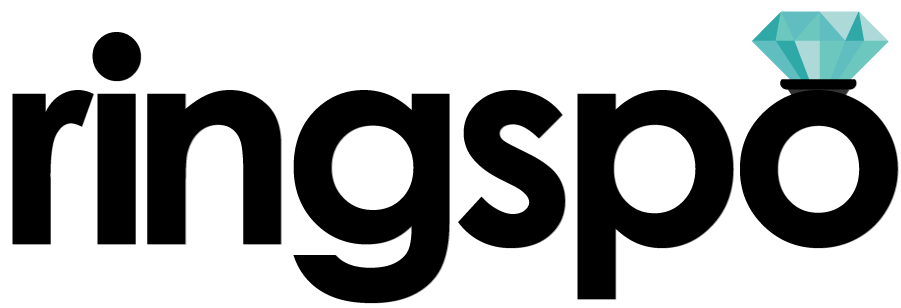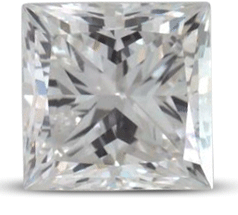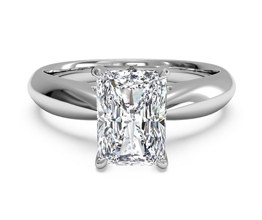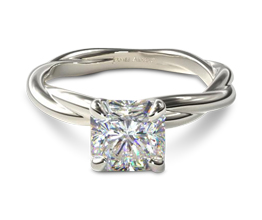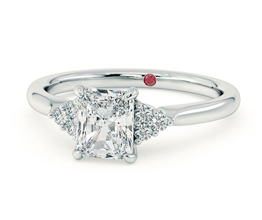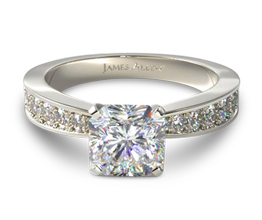Radiant engagement rings
How to get the most beautiful radiant cut diamond and the best value
Ringspo is reader supported
Ringspo is reader-supported, which means we may receive a commission if you click a link to a retailer & subsequently make a purchase.
We feature links to several retailers to help readers find the one that is the best fit for them. Find out more about how Ringspo works here.
The radiant diamond combines the very best parts of several other diamond shapes.
It was originally developed to combine the best bits of the extremely sparkly round brilliant shape, the trimmed corners of the Asscher cut and the openness and elegance of the emerald cut and definitely manages to do all of this.
Radiant cut engagement rings are actually a fairly recent development – the shape of the diamond was invented in the 1970s and the patent on the design only recently ran out, which meant that many more diamonds could be produced.
With the increase in the number of diamonds being produced has come a reduction in the cut quality, and therefore the brilliance of the stones. This guide will show you how to get a top quality stone that sparkles brilliantly.
We’re going to look at:
- What’s good about radiant cut engagement rings
- What’s bad about radiant cut engagement rings
- Radiant cut engagement ring setting styles
- A radiant cut diamond buying guide to tell you what you really need to know
- Recommended specs for your stone
Do you really know about the 4Cs?
Much of the information on this page will focus on diamonds, as getting that right is key to getting an awesome ring for a great price. If you’re not familiar with the 4Cs of diamonds then I’d recommend reading this page which gives an overview of what you really need to know.
Radiant cut diamonds have some of the greatest variety of any of the diamond shapes – they can either be a perfect square, or much more rectangular. While other diamond shapes give different names to the square and rectangular version of them (an ‘Asscher’ cut is basically just a squared-shaped ’emerald cut’) the name ‘radiant cut’ covers everything from a perfectly square stone to one that is twice as long as it is wide.

Actually, saying that we have one name for radiants is a bit misleading. The Gemological Institute of America (GIA), the world’s most prominent gem grading lab, doesn’t recognise ‘radiant’ as an official name for a shape of diamond.
Instead the GIA calls radiant shaped diamonds “cut corner modified brilliant”, which is basically saying that they are a Princess cut diamond with the corners trimmed off. This isn’t strictly true – there are definitely other differences between the Princess cut and the radiant – but their square shape and the brilliant cut mean that they do look very similar once mounted in a ring.

The biggest difference is apparent when you look through the top ‘table’ of the stone.
While the Princess cut has linear facets internally which gives a regular appearance, the Radiant is much more likely to have a ‘crushed ice’ look within it. Neither is preferable over the other, it’s down to personal preference on which one to go for.
Why radiant diamonds make a great choice
Radiant cut diamonds are well-priced
Diamonds that aren’t the traditional round shape are known as ‘fancy’ shapes, and almost all of them offer considerable savings over the cost of a round diamond.

Radiants are no different and they will usually be at least 30% less expensive than an equivalent round brilliant using the same size and quality of stone.
As a quick demonstration of the the difference in price, I reviewed the cost for both a round brilliant diamond and a radiant cut of the same size and quality at one of our recommended retailers.
- 1 carat
- Color F
- Clarity VS1
You can see the results in the table below:
| SHAPE | PRICE (US$) | DIFFERENCE (US$) | DIFFERENCE (%) |
| Round Brilliant | 6,610 | ||
| Radiant | 4,359 | -2,251 | -34.1 |
Click here to check today’s prices.
For the specs above, there’s a huge 34% to be saved by choosing a radiant cut instead of a round diamond, which is not to be sniffed at! The actual cost saving that is available will depend on the size and specification of the diamond that you are looking at, but there will always be a considerable saving available.
This knowledge could help you put more of your budget towards other aspects of the ring e.g. a bigger center stone, or it could mean that you have more money to go towards your wedding fund. Or you could spend it on anything else that tickles your fancy!
Radiants sparkle brilliantly
Because the radiant is a hybrid cut that incorporates the best features from several different shapes, it brings the best from each of them.
From the brilliant cuts, with their facets optimized to reflect as much light as possible back to the viewers eyes, the radiant gets its excellent fire and brilliance. It basically sparkles nearly as well as a round brilliant, unlike most other square cut diamonds.

The brilliance also means that the radiant is a forgiving cut – you can choose a stone with a slightly lower clarity and color grade than with other square cuts. The sparkle and brilliance will hide minor flaws in the stone and mean that the true color of the rock is disguised.
Radiant cut diamonds are practical and versatile
With its trimmed corners, the stone is much less likely to get snagged in clothing or hair than the square-cornered Princess cut. The lack of exposed corners also means that there are fewer exposed area to hit on hard surfaces, which means that the stone is less likely to get chipped or even cracked.
Lastly, the radiance is a very versatile cut: its availability in either square or rectangle shapes means that it will suit any hand. Square shaped diamonds are great for longer fingers, while rectangular shaped stones can have a flattering elongating effect on shorter fingers.
Thinks for watch out for with radiant diamonds
Radiant cuts look smaller than some other shapes
While the size of a diamond shouldn’t be the factor that a stone is judged by, unfortunately this is often the case. This is where the Radiant falls down slightly compared to some other shapes. To maximize the brilliance of the stone, the ideal proportion for a radiant cut diamond is deep, rather than wide. This means that a larger amount of the stone is hidden within the ring setting, and it looks less wide from above.
This shouldn’t be a huge issue and the difference in size compared to a round brilliant won’t be huge, but it will be noticeable compared to some shapes like the oval or emerald.
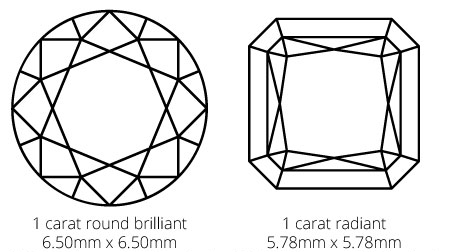
Some radiant cuts exhibit the ‘bow tie effect’
Rectangular radiant diamonds may feature the undesirable ‘bow tie effect’, which is a dark shadow in the center of the stone. This is an issue for all elongated diamond shapes and happens when light is reflected back off the pavilion at the bottom of the stone and out of the sides of the stone, rather than back to the viewer’s eye.

It can be minimized, but it’s very difficult to eradicate completely.
Radiant cut engagement ring settings
Although radiant cut engagement rings have many positive attributes, they’re still much harder to find than some of the other, more common diamond shapes. This means that your local jeweler is very unlikely to have a wide range of rings for you to choose from.
Online jewelers offer a huge selection though. I’ve highlighted a small selection of rings here to give you an idea of what sort of ring setting styles are out there for radiant cut engagement rings, but if there are none that tickle your fancy exactly, just click through and check out the other options at each retailer.
Radiant cut diamond solitaire engagement rings
The classic and elegant solitaire lets the diamond itself do the talking and the simplicity of the design means that it’s usually the least expensive setting style to boot.
Scroll across to check out a selection of radiant cut solitaire engagement ring options, and click through to find out more about each one.
All rings shown are all available in white gold, platinum, yellow gold and rose gold.
Radiant cut pavé settings
Pavé settings are a great way to add additional brilliance to an engagement ring, with small ‘melee’ diamonds which will catch the light from almost any angle, giving incredible sparkle.
The selection below shows a variety of style that pavé marquise engagements can be presented in, each one using a different number and format of smaller diamonds. The number and size of diamonds used can make a significant difference to the price of a pavé setting.
Radiant cut diamond buying guide
There’s a huge variety of shapes and quality with radiant diamonds, so knowing what to look for to ensure your stone generates maximum sparkle is incredibly important.
In this section, we’ll at each of the ‘4Cs’ of diamonds specifically relating to radiant cut stones:
- Cut
- Color
- Clarity
- Carat
Radiant cut diamond cut quality
Finding a diamond with a great ‘Cut’ is the most important factor in ensuring that your stone sparkles as brightly as possible. The GIA issues a ‘cut’ grade for round brilliant stones, which makes finding a high quality stone easy, but there is no such grade for radiant cut diamonds unfortunately. However, there are some key things to keep in mind when choosing a radiant cut diamond:
Radiant diamond length / width ratio
One thing to think about is whether you would prefer a square or a rectangular shaped stone, and this is where the length / width ratio comes into play. A perfect square stone will have a length / width ratio of 1:1 ie. both sides are the exact same length. A ratio of 1.05 will still look like a square once it’s mounted in a ring, but if you go over this then the stone will start to look more rectangular.
For rectangular radiant cuts, a ratio of 1.2 will start to look slightly rectangular, while 1.5 will mean that it is twice as long along one edge as the other, so the stone will look very rectangular.


So far, so straightforward. Something to know though is that in longer radiant cuts there is a possibility that the bow tie effect will show. How much this affects the stone is very difficult to tell from static images, so if you’re considering a rectangular radiant cut then I would recommend going with James Allen, who offer 360 degree views of each stone so you can ensure that the bow tie effect is minimised.
Radiant Diamond Table Percentage
The ‘table’ of a diamond is the large, flat area on the top of the stone.
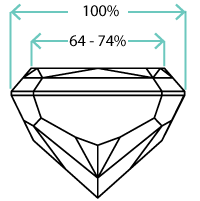
The size of the table in relation to the rest of the stone is important because it’s where the majority of light enters the stone. This needs to be carefully balanced with the other proportions to ensure that the correct amount of light enters to allow for maximum sparkle. Contrary to what you might think, a larger table is not always better.
If possible, aim for a table % in the ‘excellent’ range in the table below:
| Excellent | Very good | Good |
| 64% – 74% | 62% – 76% | 60% – 78% |
Radiant Diamond Depth Percentage
Depth percentage is the ratio of the depth to the width of the stone.

This is an important factor because if the stone is too tall it will let light leak out the bottom of the stone, and if it’s too shallow it will reflect light back at the wrong angle – both meaning that there is less light returned to your eyes, reducing the amount the stone appears to sparkle.
| Excellent | Very good | Good |
| 66% – 75% | 64% – 76.5% | 62% – 78% |
Varying from these percentages is likely to mean a higher proportion of light is lost through the sides and the bottom of the diamond and it will appear less brilliant. The best way to find a stone that fits within the recommendations is is to enter them into the ‘advanced’ options on online jewelers search tools so that you only see stone that fit within the desirable specs.
Radiant diamond color
The sparkle that is the result of the brilliant cut facets of the radiant cut make it a very forgiving cut. It means that you can go lower on the color grade than you can on other, less sparkly shapes. If you’re looking for a white diamond, it’s safe to go all the way down to H on the colour grade without any yellow tones being noticeable at all.
Of course, you can go higher than this, but as the difference between diamond colour grades is so slight, the difference in actual appearance between an H color diamond and an E color diamond will be very slight, if it is visible at all once they are both set in ring settings.
If you choose a color grade lower than H, you are more likely to be able to see ‘warmer’ tones. This is not necessarily a bad thing, but your stone won’t look quite as white as the higher color grades.
Color E – very white, but very expensive:

Color H – a great mix of color and value:

Color K – warmer tones clearly visible:

Radiant diamond clarity
Clarity is the least important of the 4Cs in terms of what a diamond looks like, but it’s often the C that guys get most obsessed about getting a high grade on. Jewelers love to show the difference between clarity grades when you look at diamonds in jewelry stores, but actually clarity makes very little difference to how impressive a diamond actually is.
With a radiant cut engagement ring, you can safely go down to SI1 if you can inspect the stone and verify that it is eye-clean. Some SI2 stones may even look eye-clean as the excellent sparkle of the radiant cut will disguise the flaws. The two best retailers that offer high quality images of each of their stones to allow you to inspect Slightly Included stones are:
With other retailers where you can’t inspect the individual stones, it’s a better bet to play it safe with a VS2 clarity stone.
You can of course go higher than these grades, but you’ll be paying for the stone to be ‘mind clean’ rather than ‘eye clean’, rather than any actual improvement in appearance.
Radiant cut diamond carat weight
Carat weight is something that people often get overly hung-up on. They want to choose a stone with a certain carat weight, even if it means that they end up making sacrifices on other, more important attributes of the ring.
The relationship between a diamond’s carat weight and its visible size isn’t always a direct one. When we judge a diamond’s size, we look at it from the top – known as the ‘face up’ position in the jewelry trade. However, much of the weight of a diamond is actually carried on the bottom half of the stone, where it can’t be seen.
The images below show the difference in size for radiant cut diamonds at a range of carat weights:

Hopefully you can see that increasing the carat weight doesn’t necessarily translate into a much visibly larger diamond. Changing the size from 0.8 carat to 1 carat is an increase in width of just over 0.4mm – less than 10%. However, the difference in price will be much more significant – almost a 60% increase.
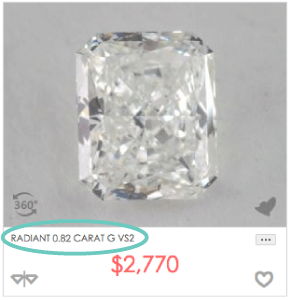
Click here to check out today’s prices for 0.8 carat radiant diamonds
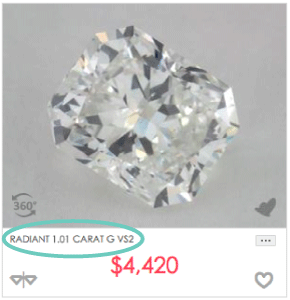
Compare to today’s prices for 1 carat radiant diamonds
The priority that you place on diamond carat weight and how bit you want to go is totally up to you. However, my recommendation is that you definitely don’t make it the most important attribute when choosing your engagement ring. Get the setting you love, find a diamond with a great cut that is going to sparkle brilliantly, make sure that it is eye-clean and has a good color and then see what carat weight you can fit into your budget.
A well-rounded diamond with excellent sparkle will much much more impressive than a big stone with obvious flaws.
Radiant diamond certification
The fifth C, and a very important one too. When looking at any diamond, you need to ensure that any diamond that you’re looking at is a ‘cert stone’, which means that it has been assessed, graded and coded with a laser by an independent lab.
Each certificate has a unique report number and detailed information about the stone, covering the four Cs, the height, depth and other info. As well as providing assurance that the stone that you’re buying is the quality that you are paying for, a certificate also proves what you’re buying is not a substitute.
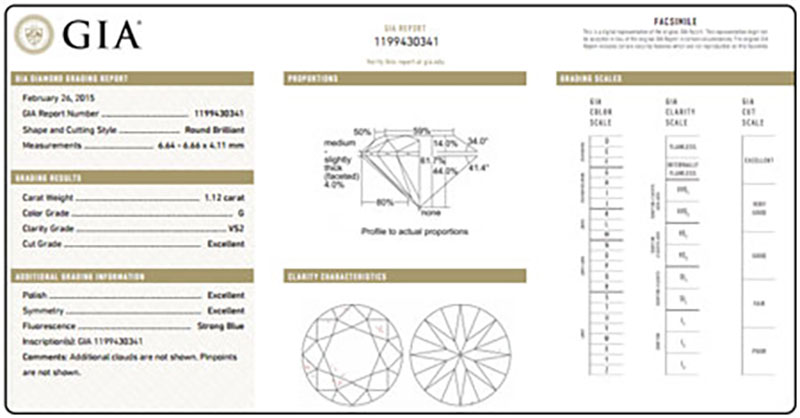
The lab to trust and to look for certification from is the non-profit Gemological Institute of America (GIA). It’s the most internationally recognised and generally seen as the most impartial of all of the gem labs.
The reason that the GIA is so well respected is because most others labs are part of trade bodies that contain jewelry retailers, or are ‘for profit’. While the GIA is very consistent with its gradings, the others have a reputation for being overly generous. What the GIA say is merely a diamond with a ‘good’ cut, maybe be graded ‘excellent’ by another lab, with an excellently large price to match.
Diamond certificates are what makes buying online safe and the best way to get a fantastic diamond at the lowest price. Knowing that each diamond you’re considering has been measured and graded by independent experts allows you to make an informed decision. You can take your time to consider the differences between diamonds and make sure you choose what experts have graded as the best stone, meaning that you get your perfect engagement ring at the best possible price.
Recommended specs
These specs are the minimum that we recommend to ensure that the diamond on your radiant cut engagement ring looks fantastic.
You can of course go higher than these specs, if your budget allows, but for many of the characteristics you are paying for improvements that are very difficult, if not impossible, to see by the naked eye, especially when mounted in a ring setting.
If you’re unsure about what any of these terms mean, check out this page which talks you through them all.
Click below to visit our top recommended retailer and see the current selection available with our recommended specs:
| Clarity: | VS2 |
| Colour: | H |
| Table %: | 64% – 74% |
| Depth %: | 66% – 75% |
| Certifying Lab: | GIA or AGS |
